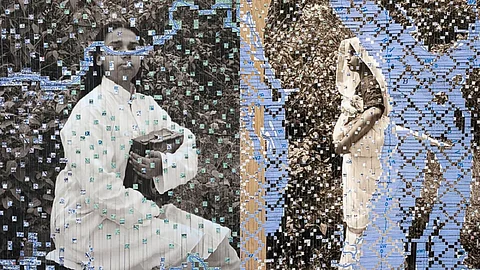
- HOMEGROWN WORLD
- #HGCREATORS
- #HGEXPLORE
- #HGVOICES
- #HGSHOP
- CAREERS
- ABOUT US
- CONTACT US

Our mind and body are repositories of memories embedded with metaphorical scars that never quite disappear. Santiniketan-born visual and performance artist Arpita Akhanda understands this astutely and portrays its nuance through her works. She is not just a weaver of materials but a weaver of experiences. Her artistic practice stretches across mediums; encompassing paper weavings, photography, performance, installations, drawings, and video pieces. Yet, a unifying thread runs through these diverse forms: the exploration of inter-generational trauma and its enduring impact on the present.
Born into a family forever marked by the displacement and violence of the 1947 Partition of India, Akhanda delves into the complexities of inherited memory. Her own body becomes a "memory collector"; a canvas upon which ancestral experiences are reimagined and projected. This investigation extends beyond personal history; prompting a critical examination of how bodies carry the weight of colonialism and its aftermath across generations.
Performative photography forms the cornerstone of Akhanda's artistic inquiry. She utilizes her body as a conduit, inhabiting various roles within her paternal grandfather's photo album; a precious relic salvaged from the chaos of Partition. This archive, containing snapshots of a freedom fighter, an artist, and a man forever severed from his homeland, becomes the catalyst for a poignant exploration of 'homeland'.
Through photo performances, archival photographs, and maps, Akhanda constructs an intricate framework of fragmented narratives. Borrowed and shared memories are weaved together; challenging the linear flow of time and history. Her work champions the marginalized, whose personal histories often drowned out by dominant narratives. It seeks to create a space where institutional memory and lived experience can coexist; fostering a more nuanced understanding of how history is constructed and remembered.
This drive to de-colonize memories extends to Akhanda's use of performance. She draws upon a wealth of family archives — poems, photographs, letters, and oral histories — to delve into the complexities of independence and Partition. By revisiting the past through performance, she dissects and analyzes the politics of sociopolitical identity and questions how history shapes and defines us.
Perhaps the most evocative manifestation of this exploration lies in Akhanda's paper weavings. Here, she creates a visual language that mirrors the fragmented nature of memory. Threads of past experiences intertwine with the fabric of the present; forming a textured surface that is "pixelated, broken, hidden, dissected, and blurred". This deliberate distortion becomes a powerful metaphor for the forgotten and lost narratives that Akhanda strives to reclaim through her art.
This brings me to Arpita Akhanda's phenomenal work Ami Utvastu Noi, which when translated from Bengali iterates as "I am not a Refugee". It exists in two iterations (I & II) and is a meticulously crafted multimedia tapestry woven from memory, trauma, and a resolute reclamation of identity. The work challenges the limitations often associated with the term 'refugee'.
Akhanda's artistic process delves into the complexities of displacement through a multi-layered approach. She utilizes staged photography and mise-en-scène to revisit undocumented moments from her family's past; a haunting legacy of the Partition of India. These photographs then become the foundation for paper weavings; a medium that allows her to physically and metaphorically reconstruct narratives.
I am not a Refugee II specifically focuses on Akhanda's paternal grandmother, Sabita Rani Akhanda. Akhanda embodies her grandmother through staged photography, depicted in a traditional white saree against the stark reality of barbed wire fencing. This powerful image serves as the warp (vertical threads) of the tapestry.
The weft (horizontal threads) weaves together a poignant narrative. A map of the river Padma – the very waterway crossed by Sabita Rani as she fled her home – is meticulously woven into the tapestry. This geographical element is further enriched by the inclusion of Bengali text proclaiming I am not a Refugee across the top border. Woven motifs from Sabita Rani's sarees add a layer of personal connection and cultural heritage.
Akhanda doesn't stop at representing the immediate displacement. The central image is framed by a weaving of river maps from Odisha, marking the region where her grandmother finally found refuge after years of searching. This border, reminiscent of traditional chatai floor mats, symbolizes both a safe haven and a grounded connection to the land.
The final touch adds a personal flourish, echoing Sabita Rani's own textile practices. The Bengali inscription Borisal and Oriya inscription Cuttack are woven at the base of the tapestry, marking her birthplace and final resting place. This act of weaving in place names becomes a powerful act of rememberence; honouring Sabita Rani's journey and reclaiming a sense of belonging.
Akhanda's 2022 iteration of I am not a Refugee at Art Dusseldorf was so impactful that it was acquired by the prestigious K21 Kunstsammlung Nordrhein-Westfalen Düsseldorf as part of their permanent collection.
Find out more about the artist here.
If you enjoyed reading this, here's more from Homegrown:
Three Museums Commemorating The Millions Affected By Post-Colonial Partitions
How Tagore Reimagined Rakhsha Bandhan To Unite Hindus & Muslims During The Partition Of 1905
Live Through The Tragedy Of Partition At A New Interactive Virtual Exhibition
